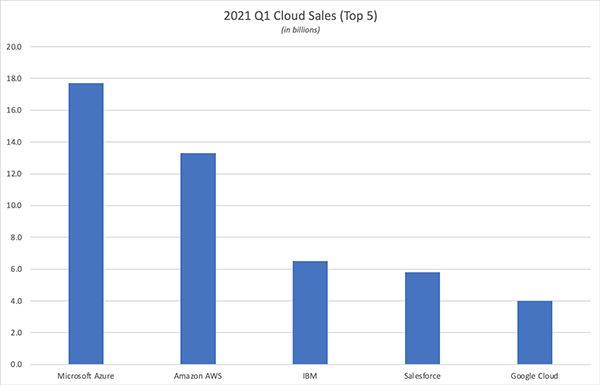Microsoft Azure is the World's Largest Cloud
Aug 16, 2021 @ 12:00 pm
/
/
 According to recent data, Microsoft Azure is the world’s largest public cloud with $17.7 billion in quarterly revenue. Amazon AWS trails not far behind at $13.3 billion. The top five (which also includes IBM, Salesforce, and Google Cloud) combined for $47.3 billion in sales.
According to recent data, Microsoft Azure is the world’s largest public cloud with $17.7 billion in quarterly revenue. Amazon AWS trails not far behind at $13.3 billion. The top five (which also includes IBM, Salesforce, and Google Cloud) combined for $47.3 billion in sales.
Microsoft and Amazon together make up 65% of the field, with others substantially smaller.
Interestingly, despite being known as a “cloud native” company, Google has fallen further behind, selling only a quarter of cloud services that Microsoft does.
Microsoft Azure has taken an impressive lead in the industry. When Azure launched in 2008 (several months after Google Cloud), they initially followed a PaaS strategy that was poorly received. But after revamping their offerings, they’ve zoomed past the original cloud innovator, Amazon, effectively leveraging the natural links between their datacenter and desktop products and the cloud.


Raindog308 is a longtime LowEndTalk community administrator, technical writer, and self-described techno polymath. With deep roots in the *nix world, he has a passion for systems both modern and vintage, ranging from Unix, Perl, Python, and Golang to shell scripting and mainframe-era operating systems like MVS. He’s equally comfortable with relational database systems, having spent years working with Oracle, PostgreSQL, and MySQL.
As an avid user of LowEndBox providers, Raindog runs an empire of LEBs, from tiny boxes for VPNs, to mid-sized instances for application hosting, and heavyweight servers for data storage and complex databases. He brings both technical rigor and real-world experience to every piece he writes.
Beyond the command line, Raindog is a lover of German Shepherds, high-quality knives, target shooting, theology, tabletop RPGs, and hiking in deep, quiet forests.
His goal with every article is to help users, from beginners to seasoned sysadmins, get more value, performance, and enjoyment out of their infrastructure.
You can find him daily in the forums at LowEndTalk under the handle @raindog308.
 According to recent data, Microsoft Azure is the world’s largest public cloud with $17.7 billion in quarterly revenue. Amazon AWS trails not far behind at $13.3 billion. The top five (which also includes IBM, Salesforce, and Google Cloud) combined for $47.3 billion in sales.
According to recent data, Microsoft Azure is the world’s largest public cloud with $17.7 billion in quarterly revenue. Amazon AWS trails not far behind at $13.3 billion. The top five (which also includes IBM, Salesforce, and Google Cloud) combined for $47.3 billion in sales.





















What killed me when I was looking at Amazon/Azure was bandwidth costs. Sure, the VM itself was $9 a month, but the bandwidth was $80/TB/mo.
I haven’t shopped around for a bit, so my impression might be a bit outdated.
Nope, that’s right. All the big public clouds are like that.
Microsoft have a vps free for one year. But, it’s true, the bandwuth prices are excesive
Microsoft offers a free virtual private server for a year. But it’s true that the fees for bandwidth are excessive.